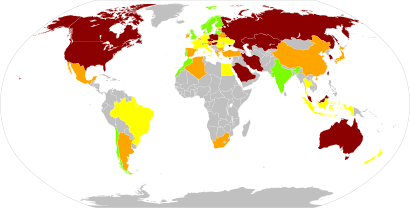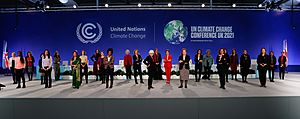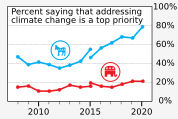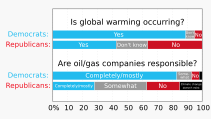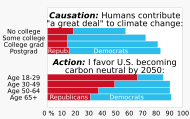Politics of climate change facts for kids
The politics of climate change is all about how different people and countries decide to deal with climate change. This global warming is mostly caused by humans releasing gases like carbon dioxide. These gases come from burning fossil fuels (like coal, oil, and natural gas), making things like cement and steel, and changing how we use land for farming and forests.
For a long time, fossil fuels have been the main way we get energy for growth and new technologies. Because of this, many industries that use a lot of carbon have resisted policies that would help the climate. This happens even though most scientists agree that these policies are needed.
Climate change first became a political topic in the 1970s. Since the 1990s, trying to slow down climate change has been a big part of international talks. It's also being looked at more and more at national and local levels. Climate change is a very complicated global problem. Greenhouse gases cause warming all over the world, no matter where they come from. But the effects of global warming are different for each place, depending on how easily they can be harmed.
Overall, global warming is having bad effects, and these are expected to get worse as temperatures rise. Also, countries have different ways to use fossil fuels or clean energy sources. Because countries have different responsibilities, benefits, and threats from climate change, early meetings about it didn't do much. They mostly made general statements and non-binding promises from richer countries to cut emissions.
In the 2000s, there's been more focus on things like climate finance. This helps countries that are easily harmed to get ready for climate change. Some countries and local areas have even adopted strong climate-friendly policies. These policies go beyond what was agreed upon internationally. However, local cuts in greenhouse gases won't slow global warming unless the total amount of these gases worldwide goes down.
Since 2020, it's become much easier to replace fossil fuels with renewable energy sources. Some countries now get almost all their electricity from renewables. More people know about the climate change threat. This is largely thanks to young people leading movements and seeing the effects of climate change. These effects include extreme weather events and floods from sea level rise.
Many surveys show that more voters want tackling climate change to be a top priority. This makes it easier for politicians to support policies that include climate action. The COVID-19 pandemic and economic problems led to calls for a "green recovery". Some places, like the European Union, have successfully added climate action into their new policies. By 2019, people who completely denied climate change had much less influence. Now, the opposition often tries to encourage delays or inaction instead.
Contents
- How Climate Change Affects Us
- History of Climate Action
- Climate Policies Around the World
- Groups Influencing Climate Politics
- Working Together for Climate Action
- What's Next for Climate Politics?
- Fair Transition
- Different Political Views on Climate Change
- Climate Science and Politics
- See also
- Images for kids
How Climate Change Affects Us
Global warming is caused by human emissions of greenhouse gases. By 2021, average temperatures had already gone up about 1.2 degrees Celsius above levels from before the Industrial Revolution. This rise has already led to many plants and animals disappearing. It has also caused thousands of human deaths.
At the 2015 Paris conference, countries agreed to try to keep future temperature rises well below 2 degrees Celsius. They also agreed to try to limit them to 1.5 degrees Celsius. Specific actions to reach this goal haven't been fully decided yet. With current policies, global warming is expected to reach about 3 degrees Celsius by 2100. The impact of global warming could get much worse if certain climate tipping points are reached. These are points where changes become irreversible.
Even if strong political agreements are made to keep warming between 1.5 and 2 degrees Celsius, there will still be big economic problems. For example, a 2-degree rise could cause sea levels to rise. This would harm many island nations and low-lying areas like Bangladesh or Florida. A 3-degree rise would greatly increase deadly wet-bulb temperatures. This could lead to millions of deaths in the tropics, unless people can move or find reliable air conditioning.
History of Climate Action
Climate change became a big topic in global politics in the early 1990s. Since then, United Nations Climate Change conferences, also called COPs, have happened every year. Important COPs include the 1997 Kyoto Protocol, the 2009 Copenhagen Summit, and the 2015 Paris conference.
The Kyoto Protocol seemed promising at first, but its results were disappointing by the early 2000s. Copenhagen was a big try to do more than Kyoto, but it mostly failed. The Paris conference was seen as a success. However, we still need to see how well it will actually reduce long-term global warming.
At the international level, countries can try three main ways to cut emissions. First, they can set goals for reducing emissions. Second, they can set a carbon price, which makes pollution more expensive. Third, they can create voluntary ways to encourage emission cuts, like sharing information and reviewing progress. These approaches can work together. However, at many conferences, the focus has often been on just one approach.
Until about 2010, international talks mostly focused on emission targets. The success of the Montreal Protocol in reducing ozone-damaging emissions suggested that targets could work. But for greenhouse gases, targets haven't generally led to big cuts. Ambitious targets usually haven't been met. Attempts to create strong penalties for not meeting targets have always been blocked by at least one or two countries.
In the 2000s, most people agree that a carbon price is the best way to cut emissions, at least in theory. But countries have been slow to adopt a high carbon price, or often any price at all. One big reason is "carbon leakage". This happens when activities that produce greenhouse gases move to places without a carbon price. This means the original country loses jobs and money, and the emissions still happen elsewhere.
Still, the percentage of the world's emissions covered by a carbon price grew from 5% in 2005 to 15% by 2019. It should reach over 40% once China's carbon price is fully in place. Most existing carbon pricing systems have been set up by the European Union, individual nations, or local areas on their own.
The voluntary "pledge and review" system, where countries make their own plans for cutting emissions, started in 1991. It was stopped before the 1997 Kyoto Protocol, which focused on "top-down" emission targets. This approach was brought back at Copenhagen and became more important with the 2015 Paris Agreement. Now, pledges are called nationally determined contributions (NDCs). These are supposed to be updated and improved every 5 years. We'll see how effective this approach is. Some countries submitted stronger NDCs in 2021, around the time of the Glasgow conference. Rules for carbon trading were agreed upon at the 2021 Glasgow meeting.
Climate Policies Around the World
Policies to cut greenhouse gas emissions are set by national or local governments, or by regions like the European Union. Many of the emission reduction policies put in place have gone beyond what international agreements require. For example, some individual US states have started carbon pricing. Costa Rica got 99% of its electricity from renewable sources in the 2010s.
Most decisions to cut emissions or use clean technologies are made by individuals, businesses, and other groups, not directly by governments. But national and local governments set policies to encourage climate-friendly actions. These policies generally fall into four types:
- First, using carbon pricing and other financial rewards.
- Second, setting rules, like requiring a certain percentage of electricity to come from renewables.
- Third, direct government spending on climate-friendly activities or research.
- Fourth, sharing information, educating people, and encouraging voluntary climate-friendly behavior.
Local politics sometimes combines with air pollution efforts. For example, creating low emission zones in cities can also aim to cut carbon from road transport.
Groups Influencing Climate Politics
Individuals, businesses, and NGOs (non-governmental organizations) can influence climate change politics directly and indirectly. They do this through public speaking, opinion polls, and large protests. In the past, many protests were against climate-friendly policies. For example, since the 2000 UK fuel protests, there have been many protests worldwide against fuel taxes or ending fuel subsidies.
Since 2019, with the rise of the school strike movement and Extinction Rebellion, protests supporting climate action have become more common. Other ways non-political groups influence things include funding or working on green technologies, and the fossil fuel divestment movement. This movement encourages organizations to stop investing in fossil fuel companies.
Special Interest Groups
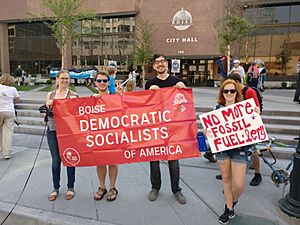
Many special interest groups, organizations, and companies have public and private views on global warming. Here are some examples:
- Fossil fuel companies: These companies might lose money from stricter global warming rules. However, some might benefit from new energy trading systems.
- Farmers and agribusiness: They have different views on how climate change affects farming and how farming causes greenhouse gas emissions.
- Financial Institutions: Banks and financial groups generally support policies against global warming. They especially like carbon trading systems and new markets that put a price on carbon. They can profit from setting up these trading systems and investing in them.
- Environmental groups: These groups usually want strict limits on carbon dioxide emissions. They work to raise public awareness.
- Renewable energy companies: Companies in wind, solar, and energy efficiency generally support stronger global warming policies. They expect their business to grow as fossil fuels become more expensive.
- Nuclear power companies: They support and benefit from carbon pricing or support for low-carbon energy. This is because nuclear power produces very few greenhouse gases.
- Electricity companies: They might lose from solar panels on homes but gain from more electric vehicles.
- Retailers and marketers: These companies often adopt "green" policies if it appeals to their customers. They might do small things to please customers, but usually don't lobby strongly for or against climate policies.
- Medics: Doctors and health professionals often say that tackling climate change and air pollution together can save millions of lives.
- Tech companies: Information and communications technology companies say their products help others fight climate change. They often benefit from less travel and many buy green electricity.
These different groups sometimes work together to strengthen their message. For example, electricity companies might fund electric school buses. This helps medics by reducing health problems and also sells more electricity. Industries sometimes fund special non-profit groups to raise awareness and lobby for them.
Working Together for Climate Action
Today's climate politics are shaped by many social and political movements. These movements focus on building public support for climate action. This includes the climate justice movement, youth climate movement, and movements to stop investing in fossil fuel industries.
Youth Climate Movement
The school strike for the climate, also known as Fridays for Future (FFF), is a worldwide movement. School students take time off from class. They join protests to demand action against global warming and climate change.
This movement became well-known after a Swedish student, Greta Thunberg, started protesting. In August 2018, she sat outside the Swedish parliament. Her sign said "School strike for the climate."
On March 15, 2019, over one million students joined a global strike. About 2200 strikes happened in 125 countries. Another big strike on May 24, 2019, saw hundreds of thousands of protesters. These events happened around the time of the 2019 European Parliament election.
The Global Week for Future in 2019 included 4500 strikes. They took place in over 150 countries. The strikes on September 20 gathered about 4 million protesters. Many were schoolchildren. This included 1.4 million people in Germany. On September 27, over 1 million people protested in Italy.The youth climate movement has become very powerful. Young people, like Greta Thunberg, have started school strikes and protests around the world. These actions have helped many more people understand the serious threat of global warming. They show that young people are very concerned about their future.
What's Next for Climate Politics?
Past political attempts to agree on policies to limit global warming have mostly failed. Some experts are hopeful that the 2020s can be more successful. This is because of new developments and chances that weren't there before. Other experts warn that there is very little time left to keep warming below 1.5 degrees Celsius, or even to keep it under 2 degrees Celsius.
New Opportunities
In the late 2010s, several positive changes for climate-friendly politics made experts hopeful. They thought the 2020s might see good progress in dealing with global warming.
Changing Public Opinion
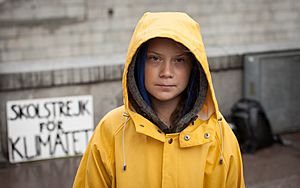
The year 2019 has been called "the year the world woke up to climate change." This was driven by more people recognizing the threat of global warming. This recognition came from recent extreme weather events, the "Greta effect" (Greta Thunberg's influence), and a special report by the IPCC about limiting warming to 1.5 degrees Celsius.
In 2019, the head of OPEC (an organization of oil-producing countries) said the school strike movement was the biggest threat to the fossil fuel industry. According to Christiana Figueres, when about 3.5% of a population takes part in peaceful protests, they always succeed in causing political change. The success of Greta Thunberg's Fridays for Future movement suggests this number might be reached.
Less Climate Change Denial
By 2019, outright climate change denial had much less influence than in previous years. This is because extreme weather events are happening more often. Also, climate scientists are communicating more effectively, and the "Greta effect" has raised awareness. For example, in 2019, the Cato Institute, a group that had questioned climate change, closed its climate section.
Growth of Renewable Energy
Renewable energy comes from natural sources that replenish themselves, like wind, solar, hydropower, geothermal, and biomass. In 2020, renewable energy produced 29% of the world's electricity.
After the Paris Agreement, 168 countries set national renewable energy goals. Many countries use different ways to encourage renewable energy investments. For example, 102 countries offer tax credits, 101 countries have public investments, and 100 countries use tax reductions. The biggest carbon dioxide emitters are often industrial countries like the US, China, UK, and India. These countries need to create more industrial policies (like supporting green industries) alongside their deployment policies (like installing solar panels). Policies need to work together to be most effective.
In November 2021, the 26th United Nations Climate Change Conference (COP26) happened in Glasgow, Scotland. Nearly 200 nations agreed to speed up the fight against climate change. They also promised to make stronger climate pledges. Some new promises included reforms on methane gas pollution, stopping deforestation, and ending coal financing. Surprisingly, the US and China, the two largest carbon emitters, also agreed to work together. They aim to prevent global warming from going above 1.5 degrees Celsius.
Some scientists, politicians, and activists argue that not enough was done at this summit. They believe we will still reach the 1.5-degree tipping point. An independent report by Climate Action Tracker said the promises were "lip service." It stated that "we will emit roughly twice as much in 2030 as required for 1.5 degrees."
By 2020, it became much more possible to replace fossil fuels with nuclear and especially renewable energy. Dozens of countries now get more than half of their electricity from renewable sources.
Green Recovery
Challenges Ahead
Even with promising conditions, experts warn that several difficult challenges remain. These must be overcome for climate change politics to lead to a big cut in greenhouse gas emissions.
Urgency of Action
By 2021, carbon dioxide levels had already gone up about 50% since before the Industrial Revolution. Billions more tons are released every year. Global warming has already started causing terrible impacts in some places. So, big policy changes need to happen very soon to avoid the risk of even worse environmental problems.
Fossil Fuels are Still Key
Energy from fossil fuels is still central to the world's economy. In 2019, it accounted for about 80% of energy production. Suddenly removing government support for fossil fuels from consumers has often caused protests. While clean energy can sometimes be cheaper, providing large amounts of renewable energy quickly can be hard.
A 2021 report by the International Energy Agency said that carbon dioxide emissions from fossil fuels were set to rise by 4.8% in 2021. This would be the second highest rise ever, mostly driven by more coal burning. In 2022, the European Central Bank said that high energy prices were speeding up the shift away from fossil fuels. But they also said governments should help prevent energy poverty without stopping the move to clean energy.
Delaying Action
While outright denial of climate change is less common now, many arguments are still made against taking action. Some say there are better ways to spend money. Others say it's better to wait for new technology to make cutting emissions cheaper. Some also believe that future negative effects of climate change should be considered less important than current needs.
Influence of Fossil Fuel Companies
The biggest oil and gas companies, known as Big Oil, and their lobbyists spend a lot of money. They try to stop or delay government action on climate change. The fossil fuel lobby has a lot of power in places like Washington, D.C., the European Union, and the United Kingdom. These companies spend much more money trying to influence decisions than regular citizens and environmental groups. For example, they spent $2 billion on climate change lobbying in the United States between 2000 and 2016.
Big Oil companies often say they support "sustainability." But their lobbyists often try to create doubt about climate change and prevent government efforts. The American Petroleum Institute (API) launched a public relations campaign to make people doubt climate change. This was done so that "climate change becomes a non-issue." This industry also spends a lot on political campaigns in America. About two-thirds of their political donations over the past decades went to Republican Party politicians. They outspend renewable energy supporters many times over.
These political donations reward politicians who vote against environmental protections. A study found that as a member of the United States Congress voted more against environmental protection, they received more money from the fossil fuel industry. On average, a 10% drop in their environmental voting score was linked to an increase of $1,700 in campaign donations from the fossil fuel industry for the next election.
Hiding Climate Science
Starting as early as the 1970s, Big Oil companies hid reports from their own scientists. These reports showed the big climate impacts of burning fossil fuels. ExxonMobil started a campaign to spread false information about climate change. This tactic has been compared to how tobacco companies tried to trick the public about the dangers of smoking.
Think tanks funded by the fossil fuel industry bothered climate scientists who spoke publicly about the serious threat of climate change. As early as the 1980s, when more Americans started learning about climate change, some US presidents' administrations criticized scientists who spoke about the threat of fossil fuels. Other US administrations have silenced climate scientists and stopped government whistleblowers from speaking out. Political appointees in some government agencies prevented scientists from sharing their findings. They changed data to fit what they wanted to prove and ignored career scientists.
Challenges for Climate Activists
Climate and environmental activists face many dangers. In some countries like Colombia, Brazil, and the Philippines, activists, especially those protecting forests from logging, have been killed. Most of those who commit these killings are not punished. A record number of such killings happened in 2019. Indigenous environmental activists are harmed much more often, making up as many as 40% of deaths worldwide.
Some governments' intelligence services have seen environmental activists and climate change groups as "domestic terrorists." They watch them, investigate them, question them, and put them on national "watchlists." This can make it harder for them to travel and can lead to local police monitoring them. Other tactics in the U.S. have included stopping media from covering American citizen protests against climate change. They also work with private security companies to watch activists.
Feeling Hopeless (Doomism)
In climate change politics, "doomism" means believing it's too late to do anything about climate change. This can include exaggerating the chance of climate tipping points. It also includes believing that runaway global warming is unavoidable, even if humans stopped all fossil fuel burning immediately. In the US, polls found that people who didn't support more climate action often said it was because they believed it was too late. This reason was given more often than skepticism about human-caused climate change.
Lack of Agreement
Some climate-friendly policies have been blocked by environmental or left-leaning groups and parties. For example, in 2009, the Australian Green party voted against a carbon pricing plan. They felt it didn't set a high enough carbon price. In the US, the Sierra Club helped defeat a 2016 climate tax bill. They thought it wasn't fair to everyone. Some attempts to put a carbon price in US states have been blocked by left-wing politicians. This happened because the price was to be set by a "cap and trade" system, rather than a direct tax.
Working Across Many Areas
Climate change affects many different areas of life. This means that climate change policies often need to be included in other policy areas. This makes the problem hard to solve. It needs to be addressed at many levels, with different groups involved in a complex process of managing things.
Bad Adaptation
Successfully adapting to climate change means balancing different economic, social, and political interests. If this balance isn't found, efforts to adapt can have bad, unexpected results. For example, trying to protect coral reefs in Tanzania forced local villagers to stop traditional fishing. They had to switch to farming, which actually produced more greenhouse gas emissions.
Technology's Role
New technology is seen as both a problem and a potential solution. New technologies can open up ways for new and more effective climate policies. Most plans that show a way to limit warming to 2 degrees Celsius rely heavily on carbon dioxide removal. This is one of the two main types of climate engineering. People from all political views generally welcome carbon dioxide removal. But some are doubtful that it can remove enough carbon dioxide to slow global warming without also making fast cuts in emissions. They warn that too much hope in such technology might make it harder to pass policies to cut emissions.
There's a different view on the other main type of climate engineering, solar radiation management. At least with the method that uses sulphur-based aerosols, there's general agreement that it would lower average global temperatures. But many climate scientists don't like this idea. They warn that side effects could include less sunlight and rainfall, which might reduce farm harvests. It could also cause local temperature rises and other weather problems. According to Michael Mann, the idea of using solar management to reduce temperatures is another argument used to make people less willing to pass emission reduction policies.
Fair Transition
Changes in the economy from stopping carbon-heavy activities can be politically sensitive. This is true for things like coal mining, cattle farming, or bottom trawling. These jobs are very important in some countries. Many labor and environmental groups support a "just transition". This means making sure that changes related to climate action cause the least harm and the most good for society. For example, it could mean providing job training for workers in changing industries.
Different Political Views on Climate Change
Climate-friendly policies are generally supported across the political spectrum. However, there have been many exceptions among voters and politicians who lean right. Even politicians on the left have rarely made climate change their top priority. Some countries and people don't want to cut greenhouse gas emissions or enforce laws. This is because they would have to pay the full cost of doing so.
In the 20th century, right-wing politicians led important actions against climate change, both internationally and at home. Richard Nixon and Margaret Thatcher are good examples. But by the 1990s, especially in some English-speaking countries like the US, the issue became divided. Right-wing media started saying that climate change was made up or exaggerated by the left to make government bigger.
As of 2020, some right-wing governments have put in place more climate-friendly policies. Various surveys showed a slight trend for even US right-wing voters to become less doubtful about global warming. However, according to Anatol Lieven, for some right-wing US voters, doubting climate change has become part of their identity. So, their position on the matter can't easily be changed by facts.
A 2014 study found that countries with center and left-wing governments cut emissions more than right-wing governments in rich countries between 1992 and 2008. Historically, nationalist governments have been among the worst at putting policies in place. But according to Lieven, as climate change is increasingly seen as a threat to countries themselves, nationalism might become a strong force to drive serious efforts to slow warming. Seeing climate change as a security threat might be especially good at getting support from nationalists and conservatives.
Climate Science and Politics
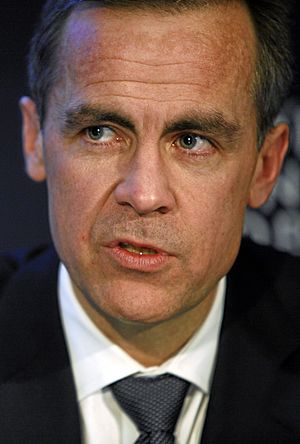
In scientific papers, there is an overwhelming agreement that global surface temperatures have risen in recent decades. This trend is mainly caused by human-made emissions of greenhouse gases.
Sometimes, science is used or changed for political reasons. This is part of political debates. For example, some groups have been accused of purposely hiding findings about things like tobacco smoke, ozone depletion, global warming, or acid rain. However, in the case of ozone depletion, global rules based on the Montreal Protocol were successful. This happened even with a lot of uncertainty and strong resistance. But for climate change, the Kyoto Protocol failed.
The IPCC (Intergovernmental Panel on Climate Change) tries to gather and organize climate change research to build a worldwide agreement. But the IPCC itself has been affected by politics. Human-caused climate change has grown from just a science issue to a top global policy topic.
Even though the IPCC has built a broad scientific agreement, governments still follow different, sometimes opposing, goals. For the ozone depletion problem, global rules were put in place even before a full scientific agreement was reached. So, the idea that "the more we know, the better the political response will be" isn't always true. Instead, managing knowledge and uncertainties for political decisions needs a better understanding of how science, public understanding (or lack of it), and policy are connected.
Most of the political debate about slowing climate change has focused on predictions for the 21st century. Experts have criticized this as short-term thinking. Decisions made in the next few decades will have environmental effects that will last for thousands of years.
It's estimated that only 0.12% of all money for climate research is spent on the social science of climate change solutions. Much more money is spent on natural science studies of climate change. A lot is also spent on studies of climate change impacts and how to adapt. Some argue this is a wrong way to use resources. They say the most urgent puzzle now is to figure out how to change human behavior to slow climate change. The natural science of climate change is already well understood, and there will be decades and centuries to deal with adaptation.
See also
 In Spanish: Políticas sobre el calentamiento global para niños
In Spanish: Políticas sobre el calentamiento global para niños
Images for kids


